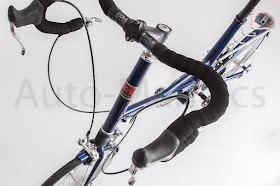So this is mine now. I was 40 recently so I decided I was allowed a mid-life crisis purchase. In my case, a 15 year-old Bridgestone Moulton purchased via eBay for a price I don't even want to think about, let alone type.
It's a folly, of course: I already own a much-modified 1960s Moulton which needs some work, and a perfectly serviceable and much more standard Forme Longcliffe 4.0 (in a much more sober colour scheme and thanks to the Cycle to Work scheme), but I decided that as I'll never be able to justify a £17,000 Moulton New Series Double Pylon, it was OK to go for this one.
If you're anything like the guys in the bike shop I went to yesterday, you're thinking 'why has he bought a folding shopper bike?'. Well it isn't. It doesn't fold, for a start. The original Moultons were the first to have suspension, front and rear, which allowed them to have small wheels at ridiculously high pressure, making them hugely fast and unlike any other bike to ride. Plus they were hand-built utterly beautifully - they became one of the icons of the swinging 60s. Last year I had the enormous pleasure of keeping up with a guy on a Pinarello to his huge annoyance and my satisfaction.
This new Bridgestone is a variant of the original – built in Japan by Bridgestone from aluminium rather than steel, with some changes in the suspension design. Mine is one of those tweaked and kitted out by the Alex Moulton factory at Bradford-on-Avon, so it's got a few special touches: carbon seat-post, Ultegra and Dura-Ace components and so on. It's in the bike shop now having the bar-end shifters replaced with STI levers.
OK, it's an indulgence but there are worse things to spend my money on. Now if only I could shake this achilles tendonitis, I might be able to get some serious miles done…





Could you explain the bit about the small wheels, the high pressure and the speed? I would have thought any bike with smaller wheels would have trouble keeping up with a larger-wheeled bike, just by virtue of how much distance the wheels cover when they turn. It sounds like I'm missing something.
ReplyDeleteYou are on the slippery slope. Pretty soon, you will realise the truth - that the correct number of bikes to own is n+1, where n = the current number of bikes.
ReplyDeleteBob - you're absolutely right. Though I am severely limited by space.
ReplyDeletePhil: according to Alex Moulton, large wheels have increased drag, whereas smaller ones with higher pressure tyres reduce rolling resistance